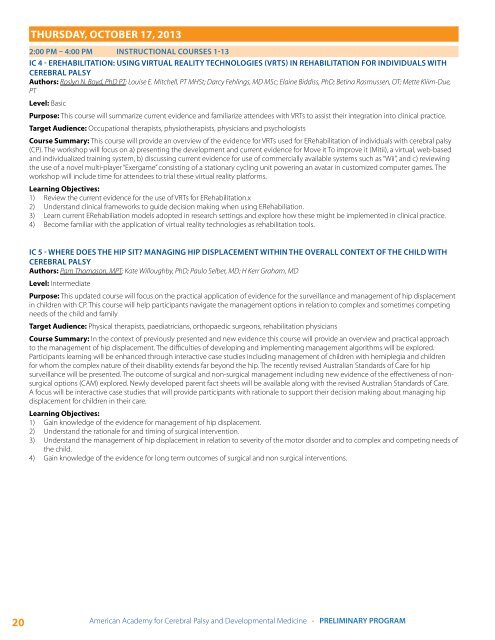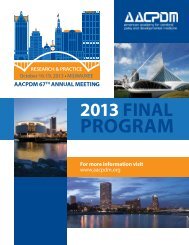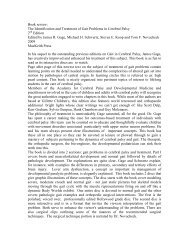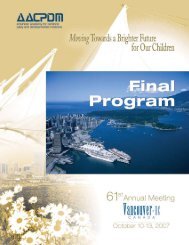program - American Academy for Cerebral Palsy and ...
program - American Academy for Cerebral Palsy and ...
program - American Academy for Cerebral Palsy and ...
Create successful ePaper yourself
Turn your PDF publications into a flip-book with our unique Google optimized e-Paper software.
Thursday, October 17, 2013<br />
2:00 pm – 4:00 pm Instructional Courses 1-13<br />
IC 4 - EREHABILITATION: USING VIRTUAL REALITY TECHNOLOGIES (VRTS) IN REHABILITATION FOR INDIVIDUALS WITH<br />
CEREBRAL PALSY<br />
Authors: Roslyn N. Boyd, PhD PT; Louise E. Mitchell, PT MHSt; Darcy Fehlings, MD MSc; Elaine Biddiss, PhD; Betina Rasmussen, OT; Mette Kliim-Due,<br />
PT<br />
Level: Basic<br />
Purpose: This course will summarize current evidence <strong>and</strong> familiarize attendees with VRTs to assist their integration into clinical practice.<br />
Target Audience: Occupational therapists, physiotherapists, physicians <strong>and</strong> psychologists<br />
Course Summary: This course will provide an overview of the evidence <strong>for</strong> VRTs used <strong>for</strong> ERehabilitation of individuals with cerebral palsy<br />
(CP). The workshop will focus on a) presenting the development <strong>and</strong> current evidence <strong>for</strong> Move it To improve it (Mitii), a virtual, web-based<br />
<strong>and</strong> individualized training system, b) discussing current evidence <strong>for</strong> use of commercially available systems such as “Wii”, <strong>and</strong> c) reviewing<br />
the use of a novel multi-player “Exergame” consisting of a stationary cycling unit powering an avatar in customized computer games. The<br />
workshop will include time <strong>for</strong> attendees to trial these virtual reality plat<strong>for</strong>ms.<br />
Learning Objectives:<br />
1) Review the current evidence <strong>for</strong> the use of VRTs <strong>for</strong> ERehabilitation.x<br />
2) Underst<strong>and</strong> clinical frameworks to guide decision making when using ERehabiliation.<br />
3) Learn current ERehabiliation models adopted in research settings <strong>and</strong> explore how these might be implemented in clinical practice.<br />
4) Become familiar with the application of virtual reality technologies as rehabilitation tools.<br />
IC 5 - WHERE DOES THE HIP SIT? MANAGING HIP DISPLACEMENT WITHIN THE OVERALL CONTEXT OF THE CHILD WITH<br />
CEREBRAL PALSY<br />
Authors: Pam Thomason, MPT; Kate Willoughby, PhD; Paulo Selber, MD; H Kerr Graham, MD<br />
Level: Intermediate<br />
Purpose: This updated course will focus on the practical application of evidence <strong>for</strong> the surveillance <strong>and</strong> management of hip displacement<br />
in children with CP. This course will help participants navigate the management options in relation to complex <strong>and</strong> sometimes competing<br />
needs of the child <strong>and</strong> family<br />
Target Audience: Physical therapists, paediatricians, orthopaedic surgeons, rehabilitation physicians<br />
Course Summary: In the context of previously presented <strong>and</strong> new evidence this course will provide an overview <strong>and</strong> practical approach<br />
to the management of hip displacement. The difficulties of developing <strong>and</strong> implementing management algorithms will be explored.<br />
Participants learning will be enhanced through interactive case studies including management of children with hemiplegia <strong>and</strong> children<br />
<strong>for</strong> whom the complex nature of their disability extends far beyond the hip. The recently revised Australian St<strong>and</strong>ards of Care <strong>for</strong> hip<br />
surveillance will be presented. The outcome of surgical <strong>and</strong> non-surgical management including new evidence of the effectiveness of nonsurgical<br />
options (CAM) explored. Newly developed parent fact sheets will be available along with the revised Australian St<strong>and</strong>ards of Care.<br />
A focus will be interactive case studies that will provide participants with rationale to support their decision making about managing hip<br />
displacement <strong>for</strong> children in their care.<br />
Learning Objectives:<br />
1) Gain knowledge of the evidence <strong>for</strong> management of hip displacement.<br />
2) Underst<strong>and</strong> the rationale <strong>for</strong> <strong>and</strong> timing of surgical intervention.<br />
3) Underst<strong>and</strong> the management of hip displacement in relation to severity of the motor disorder <strong>and</strong> to complex <strong>and</strong> competing needs of<br />
the child.<br />
4) Gain knowledge of the evidence <strong>for</strong> long term outcomes of surgical <strong>and</strong> non surgical interventions.<br />
20<br />
<strong>American</strong> <strong>Academy</strong> <strong>for</strong> <strong>Cerebral</strong> <strong>Palsy</strong> <strong>and</strong> Developmental Medicine • PRELIMINARY PROGRAM







